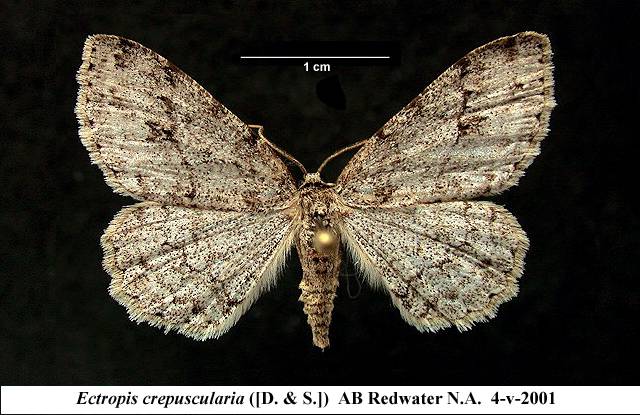« Back to your search
Species Details
Ectropis crepuscularia
University of Alberta E.H. Strickland Entomological Museum Read more about this collection »
Common NameThe Small Engrailed
SeasonalityAdults fly in spring, peaking in May.
IdentificationA light gray moth with indistinct mottling and poorly-defined AM, median and PM lines. Recognizable by the very short male antennal pectinations and the dark patch in the subterminal line in the middle of the forewing, opposite the discal cell.
Scientific Name
Ectropis crepuscularia
Common Name
The Small Engrailed
Habitat
Boreal mixedwood and aspen forests.
Seasonality
Adults fly in spring, peaking in May.
Identification
A light gray moth with indistinct mottling and poorly-defined AM, median and PM lines. Recognizable by the very short male antennal pectinations and the dark patch in the subterminal line in the middle of the…
A light gray moth with indistinct mottling and poorly-defined AM, median and PM lines. Recognizable by the very short male antennal pectinations and the dark patch in the subterminal line in the middle of the forewing, opposite the discal cell.
Life History
Eggs are laid in groups of 10 to 20 in bark crevices and under moss on tree boles, hatching in about a week. Young larve feed on understory plants, while older larvae move into the tree canopy (Morris 1970). The pupa…
Eggs are laid in groups of 10 to 20 in bark crevices and under moss on tree boles, hatching in about a week. Young larve feed on understory plants, while older larvae move into the tree canopy (Morris 1970). The pupa overwinters in the duff layer on the ground. The twig-mimicking larvae (Saddleback Looper) have occasionally caused noticeable defoliation in BC (McGuffin 1977). A detailed larval description is given by McGuffin (1977) and the mature larva is illustrated by Wagner et al. (2001).
Conservation
Not of concern.
Diet Info
A wide range of host plants are used by the larvae, the most common species recorded by Prentice (1963) being conifers including hemlock(Tsuga), fir (Abies), douglas-fir (Pseudotsuga), larch (Larix), cedar(Thuja) and…
A wide range of host plants are used by the larvae, the most common species recorded by Prentice (1963) being conifers including hemlock(Tsuga), fir (Abies), douglas-fir (Pseudotsuga), larch (Larix), cedar(Thuja) and spruce (Picea).
Range
Found across most of temparate North America from Alaska to Florida. Also occurs in the Palaearctic region (McGuffin 1977).
References
Author
Wagner, D.L, D.L. Ferguson, T.L. McCabe and R.C. Reardon
Title
Geometroid Caterpillars of Northeastern and Appalachian Forests
Publication Date
2001
Pages
239
Author
McGuffin, W. C.
Title
Guide to the Geometridae of Canada (Lepidoptera): II. Subfamily Ennominae, 2.
Publication Date
1977
Series Title
Memoirs of the Entomological Society of Canada
Volume
101
Pages
191
Author
Morris, H. K.
Title
Saddleback Looper in British Columbia
Publication Date
1970
Volume
23
Specimen Information
There are 108 specimens of this Species.
POHL-13-00762 - Ectropis crepuscularia
University of Alberta E.H. Strickland Entomological Museum
Place CollectedCanada: Saskatchewan, Big River
Collected ByPohl, G. R.; Kutash, T. M.
Date Collected1995-05-30
BIRD37879 - Ectropis crepuscularia
University of Alberta E.H. Strickland Entomological Museum
Place CollectedCanada: Alberta, Winfield
Collected ByBird, C. D.
Date Collected2015-05-22
BIRD37880 - Ectropis crepuscularia
University of Alberta E.H. Strickland Entomological Museum
Place CollectedCanada: Alberta, Erskine
Collected ByBird, C. D.
Date Collected2015-07-02
